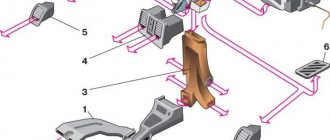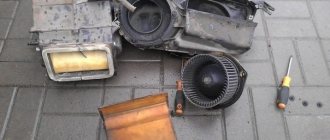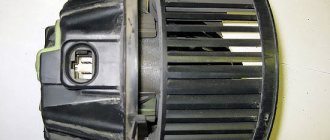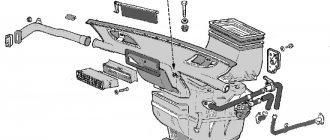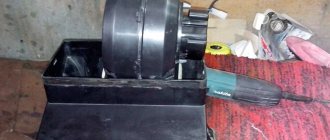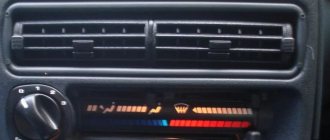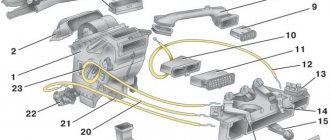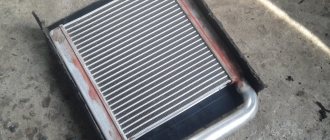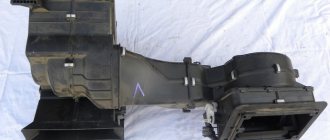Why does a resistor fail?
The cause of resistor failure is burnout.
The fact is that it is constantly energized and transmits current. Experienced craftsmen, however, claim that the failure of the resistor may be associated with malfunctions or contamination of the fan as a whole. When the resistor fails, all the electric current goes directly to the fan, and it only operates at the fourth, maximum speed. Therefore, diagnosing this breakdown will not be difficult for a car enthusiast.
Possible causes of Renault Logan heater failure
Owners of Renault Logan cars often encounter the following problems: the heater does not heat up or cold air comes out of the deflators, although the pipes (the same ones through which the coolant, heated by the engine, goes to the heater radiator) are hot. There may be several explanations for this phenomenon:
- an air plug has accumulated in the pipe;
- Cabin filters or radiator cap are clogged;
- fuses have become unusable;
- low-quality/used antifreeze or insufficient coolant level;
- the antifreeze expansion tank has become unusable (usually after 100 thousand km), or its cap is loosely secured.
Currently reading: Do-it-yourself Renault Logan 1.4 and 1.6 clutch replacement: article number and how to adjust
What you need to remember about turning on the main road at an intersection
The second group included 5 more faults. Let's look at them.
- Engine problems. Poor heater performance may be due to air pockets in the cooling system. When the engine overheats, the head gasket is damaged. Air begins to enter the water cooling system. To check, open the cap on the coolant reservoir with the engine running. If you see air bubbles, there is clearly a problem with the head gasket;
- Insufficient air flow. Here the source of trouble must be looked for in the cabin filter. The simplest solution would be replacement;
- Stove motor. Also a frequent guest on programs about poor performance of furnace equipment in Logan. If no air comes out when you turn on the heating, the motor is probably broken. It will not be possible to repair it. Replacement only;
- Fan regulator. It is connected to the motor via an electrical circuit. Check the wiring, as well as the condition of the regulator itself. If anything, for replacement;
- Radiator tap. It also happens that a faucet breaks down. That is, the valve that allows coolant to flow to the Logan heater radiator has broken. We are making a replacement.
It is extremely unlikely that all these breakdowns will happen at the same time. Often one thing goes wrong. And almost every element that requires replacement is cheap. At least in relation to Renault Logan.
You can clearly see that you can solve the problem with the stove yourself. Whether to do this or not, decide for yourself.
Thanks everyone for your attention! Subscribe, leave comments and invite your friends to join us!
Replacing the heater light bulb
The main problem with a faulty light bulb is that it can signal that the stove is not working, although the heater will function normally.
To change a light bulb you need:
- Remove the radio cover and the buttons that control the operation of the stove.
- Unscrew the fasteners of the module and press in its lower part, and pull the upper part towards you.
- Find the latches on the sides and press them out.
- Unscrew the panel and look for the burnt out light bulb.
- Replace the light bulb and perform all manipulations in reverse order.
How does the Renault Logan heater work?
Air enters the car interior - both naturally and with the help of a fan. Air coming from outside can pass through the radiator, thereby heating up, or past it. This depends on the position of the damper, which is connected to the temperature controller.
The radiator heats the air entering the cabin. This occurs due to the circulation, oddly enough, of coolant. It removes heat from the running engine, heats up and, in a heated state, flows through special pipes to the radiator. The maximum heating temperature can be up to 100 degrees - the system is closed and under pressure, which allows it to withstand such loads.
Heated air enters the cabin through deflectors - special openings located in the center and sides of the instrument panel. The air supply intensity is regulated using the heater control unit.
Heating, ventilation and air conditioning control unit Renault Sandero, Stepway
The intensity of the air supply into the cabin is regulated by turning the handle of the fan operating mode switch (with the ignition on). This turns on one of four fan speeds.
Heating, ventilation and air conditioning control unit
: 1 – air flow distribution regulator; 2 – air conditioner switch; 3 – fan operating mode switch; 4 – control lever for air recirculation mode; 5 – air temperature regulator By turning the switch handle clockwise, we increase the fan rotation speed. The flow distribution regulator sets the following directions of air flow in the cabin:
– in the area where the head is located
. The air flow through the deflectors in the instrument panel enters the upper part of the car;
– in the area where the legs and head are located
. The air flow enters through the deflectors into the upper part of the car interior and into the footwell area;
– in the area where the legs are located
. The air flow only enters the foot area;
– in the foot area and for blowing the windshield and front door windows
. The air flow enters the footwell area, as well as to the windshield and front door window vents;
– for blowing the windshield and front door windows
. The air flow flows only to the windshield and front door window vents.
By turning the handle of the air temperature regulator, we change the temperature of the air entering the cabin. To increase the air temperature, turn the regulator handle clockwise, to the red sector of the scale, and to decrease the air temperature, turn it counterclockwise, to the blue sector. To allow outside air to enter the cabin, move the air recirculation control lever to the extreme right position. To turn on the air recirculation mode, move the control lever to the extreme left position. The air recirculation mode (cutting off the supply of outside air to the cabin) is recommended to be used when it is necessary to quickly reduce or increase the air temperature in the cabin, as well as when driving in dusty areas or in dense traffic to avoid dust or exhaust gases entering the cabin.
Use recirculation mode with the door windows up. It is not recommended to use the recirculation mode for a long time, as this can lead to an increase in air humidity in the cabin and fogging of the windows. Air can enter the cabin through the central or side vents of the heating, ventilation and air conditioning system. To get air into the cabin...
...open the deflector by pressing its curtain. To change the direction of air flow...
...turn the deflector in the appropriate direction. To protect the windshield and door windows from fogging in the warm season, it is enough to direct cold air at them. To do this, you need to: – use the flow distribution regulator to direct the air through the upper windshield blower grille and the front door glass blower grilles; – move the air recirculation control lever to the extreme right position; – move the temperature regulator handle to the blue sector; – turn on the appropriate fan mode. To clear the windows of ice and snow, we direct heated air onto them by moving the air temperature control knob to the red sector and turning on the required fan operating mode. After defrosting the windows, use the air flow distribution regulator to select the desired direction of air supply to the cabin. To speed up the heating of the interior, it is recommended to turn on the recirculation mode when the car is stationary, and turn it off when driving.
How does the heating system work?
The principle by which the heating system for Renault Logan is designed has long been used by the automaker. The heater radiator is connected to the engine cooling system. Hot antifreeze circulates in it. The entry of heated air into the cabin through the air ducts is controlled by a damper controlled by a cable drive.
The fan can operate in four modes. Voltage is supplied to the fan contacts using a relay. The rotation speed is adjusted using a resistor, which is located in the device switching circuit. You can find this part behind the front panel trim, where the driver’s right foot is located. The resistor is white, and if you look under the panel you can easily find it.
To find the location of the relay, just open the hood of the Renault Logan. A mounting block is installed near the negative terminal of the battery. Here is the part you are looking for. To protect the electrical circuit for switching on the ventilation system, a 30 ampere fuse is installed. It is located in the mounting block, but located in the car interior.
Currently reading: Fuse and relay block Renault (Dacia) Logan 1, their description - New Logan
Radiator fault
Another common reason why the stove does not heat properly lies in the radiator. This part of the heating system cannot be repaired due to its thin design. If any faults are detected, the radiator will require replacement. After purchasing a new part, you can begin to remove the old one.
The procedure is simple and consists of the following steps:
- First of all, you need to drain the coolant. Otherwise, it may stain the interior in the future.
- The next step is to disconnect the pipes in the engine compartment. The crimp clamps will have to be replaced.
- To be on the safe side, you should bleed the radiator to remove any remaining coolant.
- Remove the floor covering.
- Remove the radio or plug.
- Remove the center trim of the instrument panel.
- Remove the steering column cover.
- Remove the instrument cluster and its trim.
- Tighten the nuts of the panel reinforcement and remove it.
- Unscrew the screw securing the pipes.
- Unscrew the screws securing the heating radiator, release the latches of the heater housing and remove the device.
The old device can be consigned to the abyss of history. With the new one, do the same steps, but in reverse order. After a simple procedure, the stove heats up again.
Step-by-step instruction
1. Pull the lower casing off the latches and remove it. We take it as shown below and pull it to the sides (towards the doors).
2. Remove the clip to move the carpet aside. The clip can be pryed out with a flat screwdriver.
3. We gained access to the bolts for fastening the strip that supports the rack, and the torpedo is already attached to this rack. The bar must be removed to gain access to the radiator.
Unscrew the two bolts that are marked in the photo below.
4. Squeeze on the sides and push the clip marked below inside. The wiring harness is secured to this clip.
5. Remove the ignition switch connector from the strip. We press the latch and tighten it.
6. After removing the connector, we gain access to the nuts securing the bar. Unscrew the fastening nuts and remove the bar.
When you remove the bar, don’t rush, you still need to disconnect one wiring harness.
7. After removing the strip, we had access to the heater radiator.
8. Unscrew the three Torx T20 screws.
9. Place a rag under the pipes and take them out.
10. Bend the latches and remove the radiator.
The latches literally do not bend, you just need to press them and remove the radiator.
11. Before installing a new radiator, it is advisable to blow out the seat with compressed air or clean it manually.
12. Replace the O-rings on the pipes. After replacing the rings, lubricate them a little so that they fit into the radiator easily.
13. Install the radiator.
14. Fasten the radiator with two screws.
15. Insert the pipes into the radiator and secure the retaining bar with a screw.
16. Next, fill in the coolant, bleed the system, and remove air. We check for leaks in the pipes.
17. If there are no leaks, install a metal strip and the rest. I don't think this needs any details.
Fan fault
In Renault Logan and structurally similar cars, repairing the heater fan must begin with checking the fuse. Before installing a new part, you must make sure that the fan speed switch is working correctly, otherwise you will need to replace it again. You can find the fuse in the interior mounting block. It is marked in green, and on the Renault electrical diagram it is designated as F36.
If the stove does not heat or does not work well, making a crunching or squeaking sound, then you will have to carry out repairs. In advanced cases, it may come down to a complete replacement of the node.
There is no need to remove the entire Renault Logan dashboard: just unscrew two bolts. The first is located under the facing panel of the right drain, the second is under the plug in the lower right part of the glove compartment. After unscrewing both screws, you need to remove the glove compartment from the guides by pulling it towards you. Be careful not to break anything.
A working fan needs to be cleaned, lubricated and returned to its place, repeating the sequence of actions in reverse order. If the part doesn't work, it will have to be replaced.
Selecting an electric heater motor
Most Logans are equipped with air conditioning, but there are also cars without this device. It is important to know that the heater motors for versions with and without air conditioning differ in shape and power connector.
For versions with air conditioning, a heater with a wide connector is used
On the model with air conditioning, the connector is narrow, and on the model without it, it is wide. There is practically no difference in the procedure for replacing a part, as well as in its location. The Renault Logan heater electric motor is located under the front panel in the area of the center console. It can be reached through the front passenger footwell. There are quite a few manufacturers of this unit, but structurally their products, as a rule, do not differ from the original.
On versions not equipped with air conditioning, heaters with a narrow connector are installed
Causes of stove malfunction
If it has been noticed that the efficiency of heating the interior of your Renault Logan has decreased, do not immediately panic. First you need to understand in detail what the problem is and find out the reasons. Depending on the nature of the malfunction, the interior heater may work poorly or not function at all. Let's look at the main reasons why the stove's performance is impaired:
- There is an air lock in the heating system.
- Thermostat failure.
- The pump is not working properly.
- The heater radiator is clogged.
- Problems with the heater motor.
Currently reading: Removing the rear sofa of Logan Stepway
Despite the apparent simplicity of solving these problems, they are the ones that most often force car owners to carry out independent repairs or contact a service center.
Troubleshooting minor problems
If “alarming symptoms” occur, it is necessary to consistently check the condition of the antifreeze and the vehicle components described above. If air pockets are detected in the system, they must be vented. Clogged filters and caps should be cleaned or replaced. Used antifreeze must be drained and new one added. The expansion tank can also be changed; in this case, it is better to leave the “original” lid - it will hold pressure better.
If the manipulations done do not have an effect, then the problem lies in one of the heater components.
Renault Logan heating system device
The main component of an automobile heating system is the heater heat exchanger, a more common name is the heater radiator. Its purpose is to heat the air entering the car interior to the temperature set by the driver or his passenger. The radiator heats up due to the circulation of antifreeze.
Another component of the heating system is an electrically driven fan. The fan provides air from the street and regulates this process.
The system has a damper for regulating the temperature of the air entering the car interior from the heater. Depending on the angle of rotation of the damper, the amount of air passing through the heat exchanger of the heater and the amount of outside air entering without entering the heat exchanger are regulated.
You can also indicate the presence in the system of dampers for distributing the air flow entering the car interior through air ducts from the heater. Simply put, the air that blows onto the windshield and side windows.
Find out more about the new Logan
- Cleaning the crankcase ventilation system - First maintenance (TO-1) - Renault Logan (Renault Logan) repair and maintenance
- Checking the cooling system - Engine overheating - Renault Logan (Renault Logan) repair and maintenance
- Renault Logan rear wheel bearing size
- Removing and installing the engine - Section 5. Engine - Renault Logan (Renault Logan) repair and maintenance
- Removing, installing and adjusting the hood lock and drive - Hood - Renault Logan (Renault Logan) repair and maintenance
- Interruptions in engine operation - Section 3. Malfunctions along the way - Renault Logan (Renault Logan) repair and maintenance
- Removing the engine from a Renault Logan / Renault Logan
- How to replace the front door lock cylinder of Renault Logan
USING THE AIR CONDITIONER
To turn on the air conditioner, press the switch button (see above) with the engine running. At the same time, the indicator in the button lights up. Press the button again to turn off the air conditioner.
On long climbs or in heavy city traffic, operating the air conditioner may cause the engine to overheat. Therefore, if the coolant temperature exceeds the permissible value, the air conditioner should be turned off.
If the car is parked in direct sunlight, open the windows and ventilate the interior before turning on the air conditioning.
If there is no need to turn on the air conditioner, then it must be turned on once every two weeks, for a few minutes, even during winter operation at low subzero temperatures. This helps maintain lubrication on compressor parts and seals, which extends the life of the air conditioning system.
When parked in the sun for a long time in hot weather, the air temperature in the cabin is much higher than the outside temperature. To quickly cool the interior, you need to open the doors for a while to allow hot air to escape. Then start the engine, turn on the air conditioner in maximum cooling mode and close the doors. After boarding the cabin, you should switch the air conditioning to the most favorable mode: it is recommended to maintain the difference between the internal and external temperatures within 5–9 °C. It is best to direct the cooling air flow upward, and never into your face. This can cause colds and inflammation of the facial nerves.
The maximum interior cooling mode is recommended to be used in hot weather or after the car has been parked in the sun for a long time. This mode is implemented as follows.
Air recirculation mode is turned on. The air flow distribution regulator is moved to one of its positions; The air temperature regulator is turned to the extreme position counterclockwise; fan operating mode switch – to position “4”; the air conditioner is on.
After parking the car for a long time in hot weather in the sun, when turning on the air conditioner, do not direct the flow of cold air onto the windshield to avoid the formation of cracks.
Video on the topic “Heating control unit Renault Logan, Sandero”
Removing and disassembling the climate control unit under overexposure of Renault Logan/Sandero.
Replacing heater unit backlight lamps
The reason for the poor performance of the stove on Renault Logan, Sandero, Duster, Largus

